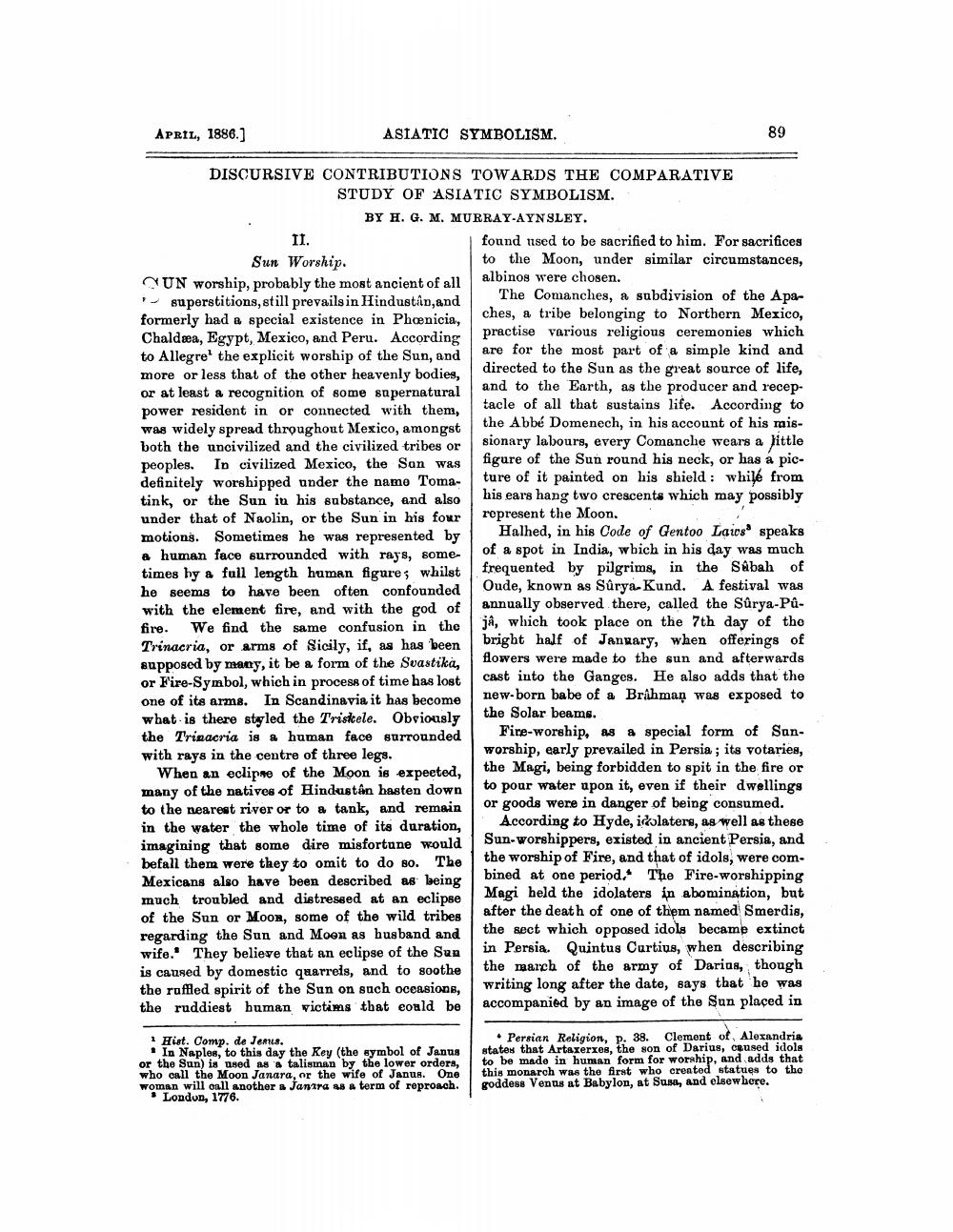________________
APRIL, 1886.]
ASIATIC SYMBOLISM.
89
DISCURSIVE CONTRIBUTIONS TOWARDS THE COMPARATIVE
STUDY OF ASIATIC SYMBOLISM.
BY H. G. M. MURRAY-AYNSLEY. II.
| found used to be sacrified to him. For sacrifices Sun Worship.
to the Moon, under similar circumstances, UN worship, probably the most ancient of all
albinos were chosen. superstitions, still prevails in Hindustan, and
The Comanches, & subdivision of the Apaformerly had a special existence in Phænicia, ches, a tribe belonging to Northern Mexico, Chaldæa, Egypt, Mexico, and Peru. According
practise various religious ceremonies which to Allegre' the explicit worship of the Sun, and
are for the most part of a simple kind and more or less that of the other heavenly bodies,
directed to the Sun as the great source of life, or at least a recognition of some supernatural
and to the Earth, as the producer and receppower resident in or connected with them,
tacle of all that sustains life. According to was widely spread throughout Mexico, amongst
the Abbé Domenech, in his account of his raisboth the uncivilized and the civilized tribes or
sionary labours, every Comanche wears a Jittle peoples. In civilized Mexico, the San was figure of the Sun round his neck, or has á picdefinitely worshipped under the namo Toma
ture of it painted on his shield: while from tink, or the Sun in his substance, and also
his ears hang two crescents which may possibly under that of Naolin, or the Sun in his four represent the Moon. motions. Sometimes he was represented by
Halhed, in his Code of Gentoo Laios speaks a human face surrounded with rays, some
of a spot in India, which in his day was much times hy a full length human figures whilst
frequented by pilgrims, in the SAbah of he seems to have been often confounded Oude, known as Sûrya Kund. A festival was with the element fire, and with the god of
annually observed there, called the Sûrya-Půfire. We find the same confusion in the JA, which took place on the 7th day of tho Trinacria, or arms of Sicily, if, as has been bright half of January, when offerings of supposed by many, it be a form of the Svastika, flowers were made to the sun and afterwards or Fire-Symbol, which in process of time has lost
cast into the Ganges. He also adds that the one of its arms. In Scandinavia it has become
new-born babe of a Brahman was exposed to what is there styled the Triskele. Obviously
the Solar beams. the Trinacria is a human face surrounded
Fire-worship, as a special form of Sanwith rays in the centre of three legs.
worship, early prevailed in Persia; its votaries, When an eclipse of the Moon is expected,
the Magi, being forbidden to spit in the fire or many of the natives of Hindustan hasten down to pour water upon it, even if their dwellings to the nearest river or to a tank, and remain or goods were in danger of being consumed. in the water the whole time of its duration, According to Hyde, isolaters, as well as these imagining that some dire misfortune would Sun-worshippers, existed in ancient Persia, and befall them were they to omit to do so. The the worship of Fire, and that of idols, were comMexicans also have been described as being
bined at one period. The Fire-worshipping much troubled and distressed at an eclipse
Magi held the idolaters in abomination, but of the Sun or Moon, some of the wild tribes after the death of one of them named Smerdis, regarding the Sun and Moen as husband and the sect which opposed idols becamp extinct wife. They believe that an eclipse of the Sun in Persia. Quintus Curtius, when describing is caused by domestic quarrels, and to soothe
the march of the army of Darias, though the ruffled spirit of the Sun on such occasions, writing long after the date, says that he was the ruddiest human victims that could be accompanied by an image of the Sun placed in
BO.
Hist. Comp. de Jemes.
In Naples, to this day the Key (the symbol of Janus or the Sun) is used as a talinnan by the lower orders, who call the Moon Janara, or the wife of Janus. One woman will onll another Janire a term of reproach.
• London, 1776.
• Persian Religion, p. 38. Clement of Alexandria states that Artaxerxes, the son of Darius, crused idola to be made in human form for worship, and adds that this monarch was the first who created statues to the goddess Venus at Babylon, at Suse, and elsewhere.




